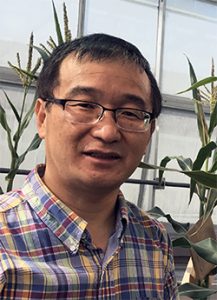Insects & Plant Pathogens

Aug. 22, 2018
Kent Shelby
Educational background Ph.D., Zoology, Oklahoma State University B.S., Biology, Oklahoma State University…

Aug. 22, 2018
Wenping Qiu
Molecular interactions between grapevine and obligate biotrophic Uncinula necator Powdery mildew caused by the fungus Uncinula necator is the most destructive fungal disease in grapevines worldwide. U. necator thrives only on living grapevine tissues by getting nutrients through an elaborate feeding structure haustoria formed between fungus and epidermal cell. Research in the Qiu laboratory focuses on understanding molecular mechanisms underlying this intimate relationship between grapevine and U. necator. The lab conducts high throughput discovery and hypothesis-based research projects hopefully, to reveal key steps in the complex interactions that happen after fungal conidiospores start to germinate on the surfaces of leaf, stem…

Aug. 22, 2018
Brenda Beerntsen
Educational background Ph.D., Veterinary Science and Entomology, University of Wisconsin M.S., Veterinary Science, University of Wisconsin B.S., Zoology, University of Wisconsin…

Aug. 21, 2018
Chin-Feng Hwang
Educational background Ph.D., Botany, University of Iowa M.S., Botany, University of Iowa…

Aug. 21, 2018
Bing Yang
Bing’s group has used rice as a workhorse to develop genome editing technologies and demonstrate their promising potential as biotech tools for basic and applied research in rice and other crop plants. With the increasingly available sequences of many plant genomes, technologies for genome editing have become the most promising and popular tools for scientists to understand such complex genomes and precisely and quickly manipulate them for good. Genome editing technologies allow precise, targeted genomic changes. TALENs and CRISPR/Cas represent the state-of-the-art genome editing technologies and hold immense promise for defining the genetic and molecular basis for valuable traits, as…

July 30, 2018
Thomas Coudron
Thomas Coudron is a research chemist in the USDA ARS, and lead scientist of a research program developing methods for propagation of beneficial insects used in biological control systems. Specific interest is how parasitoids regulate the development of their insect hosts and the nutritional ecology of insect parasitoids and predators, with an emphasis on developing artificial diets for entomophagous natural enemies. Currently he is studying the plasticity of insect digestive physiology by using nutrigenomics, immunocytohistology and enzymology to unravel the insect’s physiological and biochemical responses to changes in its nutrition. Educational background Ph.D., North Dakota State University B.S., St. John’s…

July 30, 2018
Bruce Hibbard
Educational background Ph.D., Entomology, Colorado State University B.S., Biology, St. John’s University…

Jan. 10, 2018
Xi Xiong
Educational background Ph.D., Crop Science with an emphasis in Horticulture, Oklahoma State University…

Jan. 10, 2018
Gary Stacey
Gary Stacey is Curators’ Distinguished Professor and Professor of Plant Science and Technology at the University of Missouri-Columbia. His research focuses generally on molecular aspects of plant-microbe interactions, including studies of the beneficial legume-rhizobium symbiosis and plant-fungal pathogen interactions. He has also been instrumental in the development of genomic resources for the study of soybean. He has mentored 51 postdoctoral fellows and 36 Ph.D. and 8 M.S. graduate students. Past postdocs have gone on to start independent careers in academia (e.g., Michigan State Univ., Washington State Univ.), industry, as well as winning the 2005 USA National Medal of Technology, which…

Jan. 10, 2018
Qisheng Song
Transformation of an insect from larva to adult, i.e. molting and metamorphosis, is a miracle of biology. Molting and metamorphosis provide insect with an ability to adapt to total different environmental conditions at different stages of its life cycle and is the main reason for the great success of insects on this planet. The molting process is initiated by molting hormone, mainly 20 hydroxyecdysone (20E), and ended up with cuticle sclerotization, regulated by a neuropeptide hormone bursicon. The research interests of my laboratory are mainly focused on molecular mechanisms of 20E and bursicon actions. Specifically, we are investigating the roles…
- « Previous
- 1
- 2
- 3
- Next »